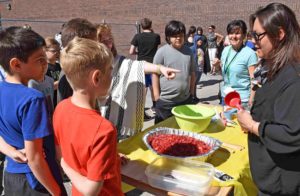Drumming for a strong community on National Indigenous Peoples Day

By Kelly Anne Smith
STURGEON FALLS—National Indigenous Day was a special time at Our Lady of Sorrows (OLS) Catholic elementary school in Sturgeon Falls. Children visited from other schools to take part in the fun culture-filled activities.
Grade 5 student Talon Beaucage proudly led the school in a prayer, speaking Anishinaabemowin. Earlier, the whole school sang out the words to O’ Canada in Anishinaabemowin.
Principal Stacey Malette credits both the board and the school with excelling in cultural events.
“It is ongoing. Students are very much a part of the planning and putting things together. The students lead on special event days and families and Elders often come to visit.”
Malette informs that over 50% of students at OLS school identifies as Indigenous. Almost 70% of students have enrolled in Native as a Second Language.
The children rotated in interactive workshops. At one area, the children learned about regalia from Nipissing First Nation Youth Chief Summer Fisher. Close by, software, teachers and a big screen had students learning the steps of different traditional dances.
Outside under a sunny sky with a pleasant breeze, Melanie Beaucage, Akkaccia and Norah oversaw rock painting. Frank Ricciuti and Tristan Croxon coached students to play lacrosse while Native as a Second Language teacher Candace Fisher and Educational Assistant Christina Beaucage showed children how to make strawberry jam. They offered strawberry teachings such as how they are considered medicinal.
Christina taught about the benefits of strawberry tea.
“I used to cut up my strawberries and throw the green part away. And then I learned you can keep it and make tea with it.” The kids made their own strawberry jam. As soon as some of the older children were done, they opened and tipped their jars to let the sun-warm jam drop to their mouths. Smiles and lick-smacking followed.
Under the shade of a tree, Native as a Second Language teacher Marianne VanBeek sang along with a circle of students with hand drums. Close by in the sun, Native as a Second Language teacher Tory Fisher led groups of children into a drum circle, then teaching how to stick with the beat.
After Tory finished singing, two boys in front of me discussed the demonstration.
“He’s good,” said one.
“Yeah, you’re good,” said the other.
“Mr. Fisher?!” “You’re good at singing.”
“Oh, Miigwech,” replied Tory.
Some of the boys complained it was too hard to drum the song again. Mr. Fisher pressed on.
“If you notice, when the dancers and the drummers get together, they have to have the same beat.”
Mr. Fisher talked about the importance of the big drum.
“On the big drum, it talks about our community. When we come together as a community, we all work together. That’s what that drum represents to us as drummers. That means we have to work together as a team, really working together on community goals and making a good sound.”
“I had an Elder tell me that your drum is as healthy as your community is. It’s a reflection of where you come from, and how your community supports you,” Mr. Fisher continued. “In language and culture and anything that you do, your drum will become stronger that way.”
Talon Beaucage looked forward to being part of the drum circle.
“Most of my uncles do it. There are all types of songs. There are friendships songs. There are round dance songs. There is always a song that everyone can connect to.”
Talon agrees the drum is important.
“It resembles mother nature’s heartbeat.”
Talon says the drumming pairs with dancing.
“I’m a grass dancer myself. I’ve always been a grass dancer.”
Talon danced in the afternoon school pow wow in his regalia.
Back indoors, Summer Fisher was educating a group of children about regalia belonging to her family. She talked about all of the different pieces of regalia laid out on tables. All the children were especially interested in holding her brother Rylan’s headpiece up their own forehead to look through the dangling beadwork. Now in Grade 6, Rylan visited three schools the week before National Indigenous Day to demonstrate his talent and skill as a traditional dancer. When Summer asked the students if anyone wanted to try on Rylan’s back piece of two bustles, there instantly appeared a line of eager boys.
Summer says educating on regalia has the children wanting to dance and become more involved.
“It brings the children together. There is no bullying involved. The more they see it, the more they think it’s normal. Especially long hair, a lot of the boys have long hair now. I feel like a lot of the bullying has gone down. It is very important they have these kind of days here where we can teach them all about it.”


